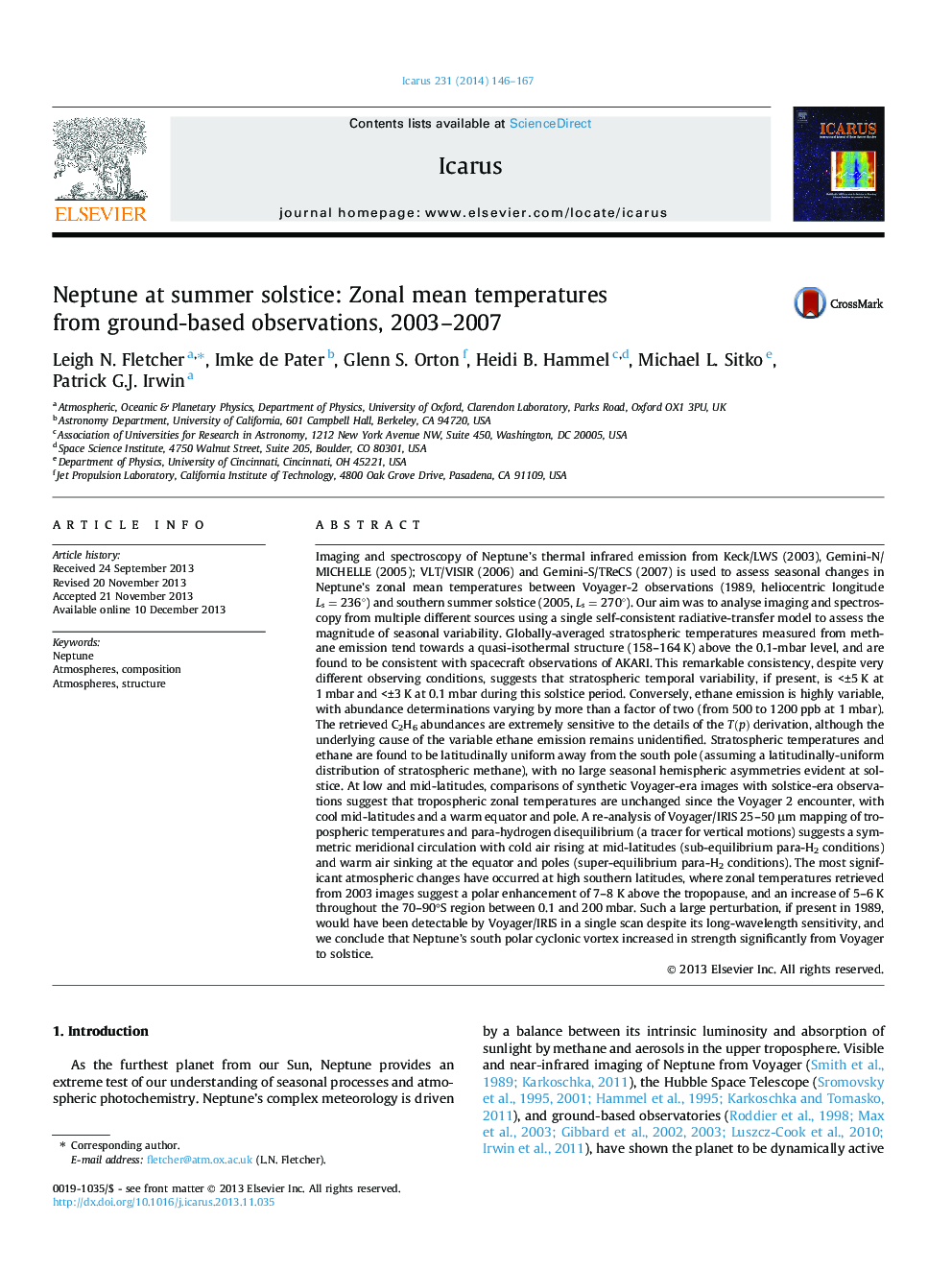| کد مقاله | کد نشریه | سال انتشار | مقاله انگلیسی | نسخه تمام متن |
|---|---|---|---|---|
| 8138575 | 1523559 | 2014 | 22 صفحه PDF | دانلود رایگان |
عنوان انگلیسی مقاله ISI
Neptune at summer solstice: Zonal mean temperatures from ground-based observations, 2003-2007
ترجمه فارسی عنوان
نپتون در انقلاب تابستانی: دمای متوسط زلزله از مشاهدات زمینی، 2003-2007
دانلود مقاله + سفارش ترجمه
دانلود مقاله ISI انگلیسی
رایگان برای ایرانیان
کلمات کلیدی
نپتون، اتمسفر، ترکیب، اتمسفر، ساختار،
موضوعات مرتبط
مهندسی و علوم پایه
علوم زمین و سیارات
علوم فضا و نجوم
چکیده انگلیسی
Imaging and spectroscopy of Neptune's thermal infrared emission from Keck/LWS (2003), Gemini-N/MICHELLE (2005); VLT/VISIR (2006) and Gemini-S/TReCS (2007) is used to assess seasonal changes in Neptune's zonal mean temperatures between Voyager-2 observations (1989, heliocentric longitude Ls=236°) and southern summer solstice (2005, Ls=270°). Our aim was to analyse imaging and spectroscopy from multiple different sources using a single self-consistent radiative-transfer model to assess the magnitude of seasonal variability. Globally-averaged stratospheric temperatures measured from methane emission tend towards a quasi-isothermal structure (158-164 K) above the 0.1-mbar level, and are found to be consistent with spacecraft observations of AKARI. This remarkable consistency, despite very different observing conditions, suggests that stratospheric temporal variability, if present, is <±5 K at 1 mbar and <±3 K at 0.1 mbar during this solstice period. Conversely, ethane emission is highly variable, with abundance determinations varying by more than a factor of two (from 500 to 1200 ppb at 1 mbar). The retrieved C2H6 abundances are extremely sensitive to the details of the T(p) derivation, although the underlying cause of the variable ethane emission remains unidentified. Stratospheric temperatures and ethane are found to be latitudinally uniform away from the south pole (assuming a latitudinally-uniform distribution of stratospheric methane), with no large seasonal hemispheric asymmetries evident at solstice. At low and mid-latitudes, comparisons of synthetic Voyager-era images with solstice-era observations suggest that tropospheric zonal temperatures are unchanged since the Voyager 2 encounter, with cool mid-latitudes and a warm equator and pole. A re-analysis of Voyager/IRIS 25-50 μm mapping of tropospheric temperatures and para-hydrogen disequilibrium (a tracer for vertical motions) suggests a symmetric meridional circulation with cold air rising at mid-latitudes (sub-equilibrium para-H2 conditions) and warm air sinking at the equator and poles (super-equilibrium para-H2 conditions). The most significant atmospheric changes have occurred at high southern latitudes, where zonal temperatures retrieved from 2003 images suggest a polar enhancement of 7-8 K above the tropopause, and an increase of 5-6 K throughout the 70-90°S region between 0.1 and 200 mbar. Such a large perturbation, if present in 1989, would have been detectable by Voyager/IRIS in a single scan despite its long-wavelength sensitivity, and we conclude that Neptune's south polar cyclonic vortex increased in strength significantly from Voyager to solstice.
ناشر
Database: Elsevier - ScienceDirect (ساینس دایرکت)
Journal: Icarus - Volume 231, 1 March 2014, Pages 146-167
Journal: Icarus - Volume 231, 1 March 2014, Pages 146-167
نویسندگان
Leigh N. Fletcher, Imke de Pater, Glenn S. Orton, Heidi B. Hammel, Michael L. Sitko, Patrick G.J. Irwin,
